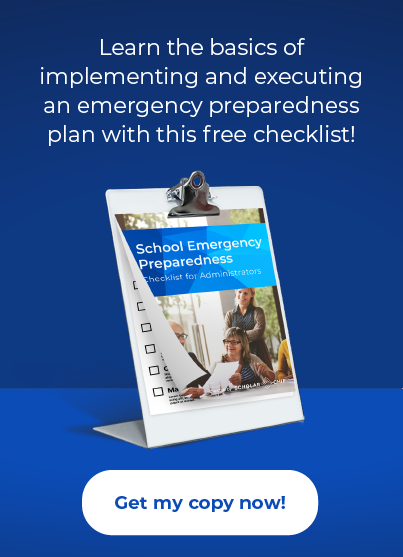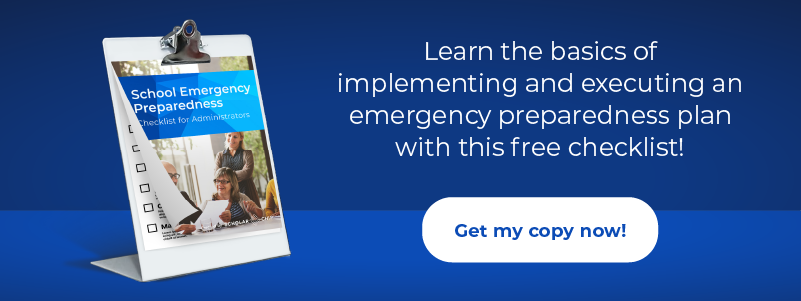September is National Preparedness Month in the United States. Coinciding with the beginning of the school year, this outreach program, developed and sponsored by FEMA, is a great reminder to school administrators that they should have an emergency preparedness plan. Creating an emergency preparedness plan for schools can be intensive. But it’s also a critical task that can keep students and staff safe from a range of hazards and threats.
Whether you’re developing a new emergency preparedness plan or updating an existing one, there are several considerations that you should keep in mind to make your plan as comprehensive as possible.
Ten Considerations When Creating Your Plan
1. Bring in Outside Voices
Your planning team should be as diverse as your school community. It should include staff members, health and mental professionals, first responders, board members, and even parents. These different perspectives ensure that all your bases are covered and that you’ve considered every feasible risk, hazard, and strategy.
2. Create a Timeline
Of course, having such a varied group working on your plan would be chaos without some direction. A timeline for developing your preparedness plan is crucial. It will help keep everyone on track and moving in the right direction and prevent miscommunications about when a work product is due.
3. Establish Goals
The goals for an emergency preparedness plan for schools should be more than just to keep students and staff safe. Your goals should focus on different areas and reflect your school’s values.
For instance, one goal may be to maintain educational continuity. This would require that any threat or hazard would include directions on how to keep the community engaged even when they can’t be physically in the building. Prevention could be another goal and would suggest a heavier focus on data, education, and training.
4. Take Time for Assessments
Thorough assessments of the school environment will ensure that you understand all your current risks completely. They can also lead to a better set of prevention steps.
For instance, a review of student behavioral issues can point to growing concerns about a specific student or group of students. Trends in absenteeism can also be a bellwether of problems at home or a bullying issue within the school. In either case, knowing this information allows a school to step in and assist the student before the problem spirals out of control.
5. Develop Plans for Realistic Incidents
There is no sense making plans for incidents that aren’t going to happen in your area. Take a look at the hazards and threats in your region, and begin to make a list. An administrator in Kansas can likely rule out planning for a tsunami, for instance, but must have a complete plan for tornadoes.
Beyond the weather and common natural disasters, look for local environmental concerns, like those from nearby businesses. Does a nearby plant have chemicals trucked in frequently? How far is the school from the nearest hospital? These kinds of questions should also filter into your planning.
Lastly, consider talking to other administrators and school officials in your regions. Getting the perspective of your peers will help you cover all your bases.
6. Think about How Improved Data Can Help
The better your data, the better you’ll be able to handle the severity or likelihood of a problem. Improved data on student behavior, attendance, and even when and how buildings are accessed can provide a clearer picture of what preventative measures can and should be taken.
Visitor data can also be used to head off threats. Simple and discreet background checks can be run on visitors as they enter the building, checking against pick-up authorizations and even sex offender databases.
7. Include Plans to Accommodate Special Needs Students and Staff
Emergency preparedness plans for schools should take into account your entire population. Your plan must include accommodations for students and staff with special needs. Because this plan will be important now and into the future, don’t focus only on the current special needs population. You don’t want to have to rework plans because a new student moves into the district or a teacher with special needs is hired.
8. Think through Communication
It’s unfair to expect administrators and staff to think of the right things to say and communicate in the midst of a crisis or immediately after an incident. Having templates for letters, emails, social media posts, and media responses on hand will remove one stressor from incidents, when you are working hard to keep the school community safe.
9. Practice (Makes Perfect)
Don’t forget to include drills and tabletop simulations in your plans. Practice creates “muscle memory” for your emergency response teams. It also gives them the opportunity to ask questions about their role and responsibilities while in a calmer environment.
10. Put Effort into Prevention Plans
A school emergency preparedness plan is about more than reacting when something happens. Actions during a crisis should be defined, of course, but incident recovery should also be detailed. Don’t forget to spend time mapping out prevention and preparation. You’ll still want to have solid response plans, but when an emphasis is placed on prevention, you may avoid ever needing to put those plans into action.
Being prepared for an emergency in your school requires time and thoughtful and thorough planning. An emergency preparedness plan for schools is much more than a list of hazards and threats or even how to deal with them should they occur. A comprehensive plan will include instructions on prevention and preparation, as well as response and recovery. It should incorporate information on how and when communication should occur and to whom, as well as the accommodations needed for all members of the student and staff population and school community. With a broader view of safety that incorporates prevention, schools can move beyond reactionary measures alone and mitigate the risks that can lead to many incidents.
ScholarChip offers holistic school safety services aligned with CDC guidelines to help schools reopen amidst growing health concerns. Through our advanced technology, built and designed for the K-12 environment, schools can identify risks and mitigate the spread of infection. Our solutions include fever screening, visitor surveys, symptom and vaccine tracking, in-school contact tracing, alerts and notifications. Learn more about our advanced COVID-19 solutions or request a reopening strategy session today!


